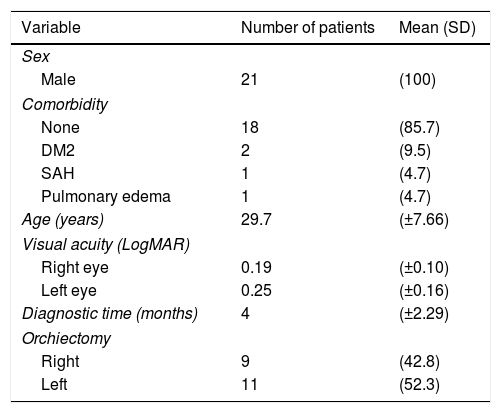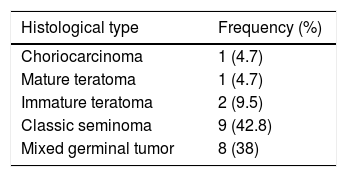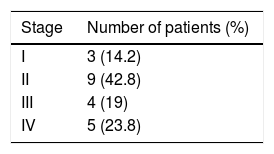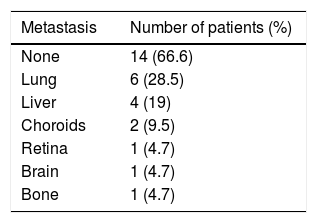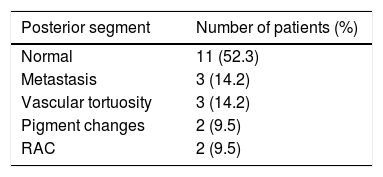The curing of a testicular tumor is currently feasible in more than 95% of patients, and in 80% of those with metastases. Until now, there has been no study or series of cases that describe the ocular changes of the posterior segment associated with testicular cancer.
ObjectiveTo evaluate patients with a diagnosis of testicular cancer in order to determine the presence of changes in the posterior segment and the relationship to the stage.
Material and methodAn observational, cross-sectional, and descriptive study was conducted on 21 male patients (42 eyes) with a diagnosis of testicular cancer. Age, histological type, time of evolution, stage, treatment, and comorbidities were recorded, as well as visual acuity measurement (LogMAR), biomicroscopy of the anterior segment, and photographic records of the posterior pole and peripheral retina.
ResultsThe mean age was 29 years (18–43 years). All (100%) of the patients were treated surgically. The most frequent histological type was classic seminoma (42.8%), followed by the mixed germinal tumor (38.0%). At the time of evaluation, 42.8% of patients had a stage II, and 23.8% had distant metastasis. The changes in the posterior segment were: vascular tortuosity (14.2%), retinopathy associated with cancer (9.5%), choroidal metastasis (9.5%), pigmentary changes of the retinal pigment epithelium (9.5%), and retinal metastasis (4.7%).
ConclusionsIt is possible to find changes at the level of retinal pigment epithelium, as well as vascular tortuosity, retinopathy associated with cancer, and choroidal and/or retina metastases.
En la actualidad la curación del tumor testicular es factible en más del 95% de los pacientes y en el 80% de los que tienen metástasis. Hasta hoy no existe ningún estudio o series de casos que describan las alteraciones oculares del segmento posterior asociadas a cáncer testicular.
ObjetivoEvaluar a pacientes con diagnóstico de cáncer testicular para determinar la presencia de alteraciones en el segmento posterior y su relación con el estadio.
Material y métodoEstudio observacional, transversal y descriptivo de 21 pacientes masculinos (42 ojos) con diagnóstico de cáncer testicular. Se registró edad, tipo histológico, tiempo de evolución, estadio, tratamiento y comorbilidades, así como medición de la agudeza visual (LogMAR), biomicroscopia del segmento anterior, registro fotográfico de polo posterior y retina periférica.
ResultadosLa edad promedio fue de 29 años (18-43 años), el 100% de los pacientes fueron tratados quirúrgicamente, el tipo histológico más frecuente fue el seminoma clásico (42,8%) seguido por el tumor germinal mixto (38%) el estadio II se presentó en el 42,8% al momento de la evaluación, el 23,8% presentaron metástasis a distancia. Las alteraciones del segmento posterior fueron: tortuosidad vascular (14,2%), retinopatía asociada a cáncer (9,5%), metástasis a coroides (9,5%), cambios pigmentarios del epitelio pigmentario de la retina (9,5%) y metástasis a retina (4,7%).
ConclusionesEs posible encontrar cambios a nivel de epitelio pigmentario de la retina, tortuosidad vascular, retinopatía asociada al cáncer y metástasis a coroides y/o retina.







